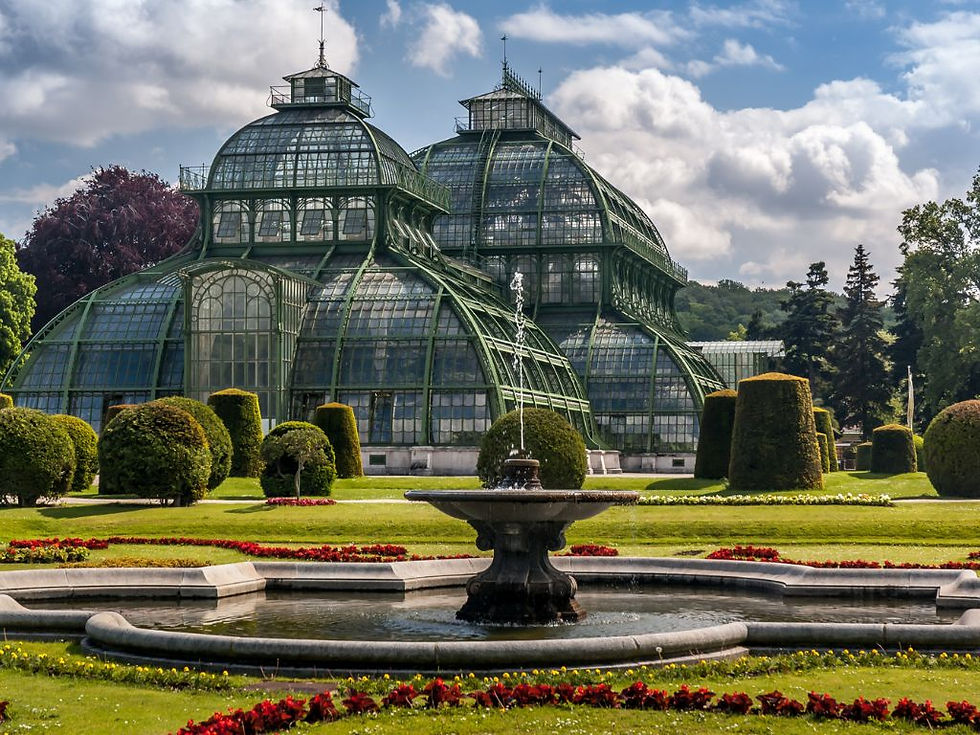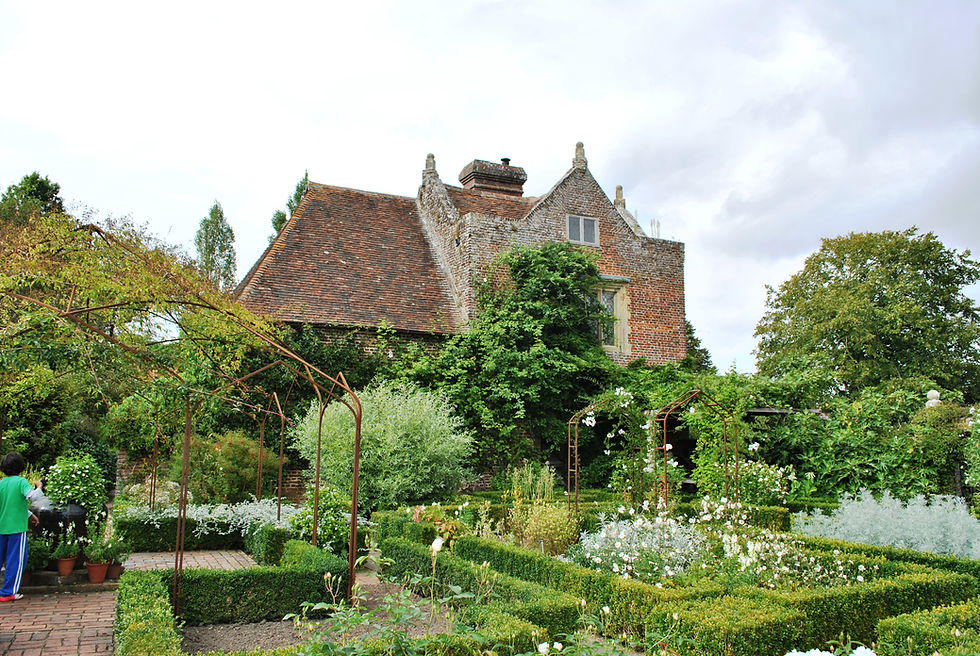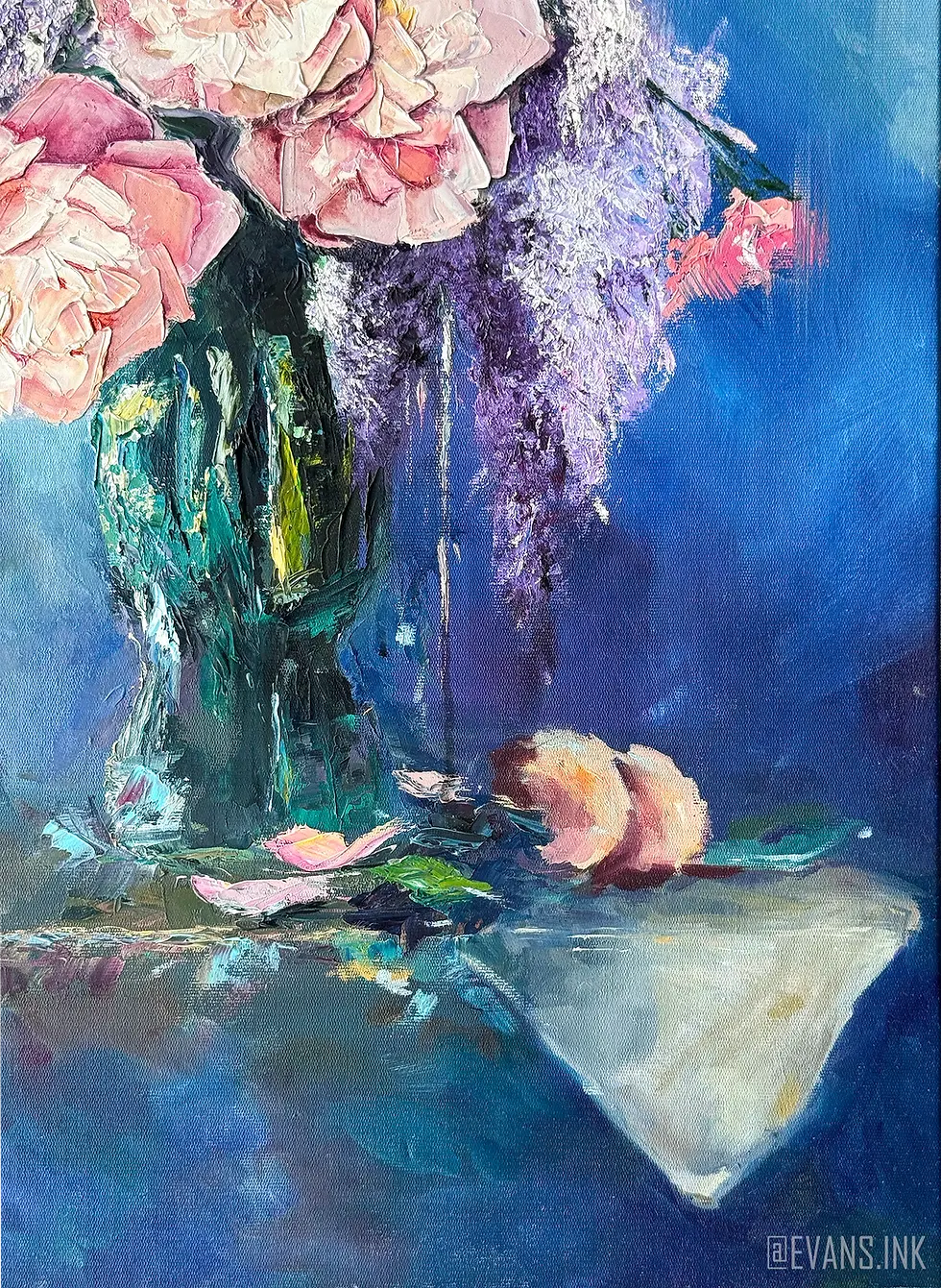The Fascinating History of Lilacs in Europe: From Balkan Hills to Victorian Gardens
- Yana Evans

- Jun 17
- 6 min read
Updated: Jul 31
Before lilacs graced Parisian courtyards or colonial New England gardens, they bloomed wild on the sun-washed hills of the Balkan Peninsula. Native to southeastern Europe—especially modern-day Albania, Serbia, and North Macedonia—Syringa vulgaris, the common lilac, was once a little-known treasure, prized for its lush purple blossoms and unforgettable fragrance.
This article traces the captivating history of lilacs in Europe, from their Ottoman roots to their celebrated role in Victorian England. Alongside this journey, I share a personal memory: while traveling through Turkey—where lilacs once adorned palace gardens—I painted an oil piece featuring lilacs and roses in my hotel room. That painting, born of history and inspiration, is featured at the end of this post and is available for purchase.
Let’s follow the path of the lilac—across borders, centuries, and stories.
Under the Crescent Moon: Lilacs in the Ottoman Empire
By the 15th century, much of the Balkans had fallen under the rule of the Ottoman Empire, a cosmopolitan realm that stretched from Hungary to Mecca. The Ottomans were great lovers of gardens, drawing inspiration from Persian, Byzantine, and Islamic traditions. Gardens were not simply places of pleasure; they were understood as earthly representations of paradise (jannah)—spaces of order, beauty, scent, and spiritual reflection.
Within this framework, aromatic and flowering plants were considered essential. Lilacs, with their early blooms and intoxicating perfume, fit perfectly into this vision. They began appearing in the private gardens of sultans and viziers, mosque courtyards, and public spaces in Constantinople (now Istanbul) and other imperial cities like Edirne, Skopje, and Thessaloniki.

Topkapı Palace Gardens – Istanbul, Turkey
Built in the 1460s, Topkapı was the primary residence of Ottoman sultans for centuries. Its imperial gardens featured roses, tulips, jasmine, and likely included lilacs by the 1500s.

Süleymaniye Mosque Gardens – Istanbul, Turkey
Completed in 1557 during the reign of Suleiman the Magnificent, this mosque complex included stunning gardens and was part of the Ottoman movement to integrate greenery into sacred spaces.
Lilacs, with their short bloom and poignant fragrance, may have been chosen for mosque gardens to evoke contemplation and the fleeting nature of life.
The Man Who Brought Lilacs to Europe: Ogier Ghiselin de Busbecq
In the grand tradition of Renaissance men, few figures were as colorful and curiously charming as Ogier Ghiselin de Busbecq (first picture). Born in 1522 in the town of Comines, nestled between present-day France and Belgium, Busbecq was not just a diplomat—he was a linguist, herbalist, historian, spy, and passionate plant collector.
Educated in the humanist spirit of the age, Busbecq studied in Louvain, Paris, and Padua, and developed an early fascination with classical texts, herbs, and the natural world. But his destiny took a sharp political turn when he was appointed by Emperor Ferdinand I (second picture) as ambassador to the Ottoman court in 1554, tasked with navigating the thorny diplomatic front between the Habsburgs and the Ottomans.
His posting was no leisurely garden tour: Busbecq had to negotiate the contested control of Transylvania, maintain fragile peace with Suleiman the Magnificent (third picture), and survive the treacherous intrigue of court politics. Yet amidst these challenges, he managed to cultivate something far more enduring—his love for Ottoman flora.
Busbecq described his experiences in a series of letters titled “Turcicae Epistolae” (The Turkish Letters), which later became widely read in Europe for their insight into Ottoman life. In these, he doesn't mention lilacs directly by name—but modern historians agree he was the one who introduced Syringa vulgaris to the West.
He encountered the lilac while admiring the private gardens of Ottoman dignitaries in Constantinople, where flowering shrubs were curated like poetry—carefully trimmed and arranged to reflect themes of love, purity, and the divine. He was captivated not just by the plant’s lavender-hued blossoms and divine scent, but by its almost mystical presence—blooming in quiet courtyards while empires clashed beyond the walls.
And so, like a Renaissance-era botanical smuggler, he sent lilac seeds and cuttings by horse, cart, and ship back to Vienna, where they were planted in imperial gardens and studied by apothecaries and horticulturists alike.
Busbecq once wrote about the peculiar habit of Ottomans grooming their plants more carefully than their pets or children. He described how they trained trees to grow in the shape of letters or curved poems, and found it both amusing and admirable. “They prune like poets,” he said. One wonders whether the lilac, too, was bent into verses before it left for Europe.

Back in Vienna, Busbecq’s cuttings took root in the Schönbrunn Palace gardens and quickly gained favor with Austrian nobles and imperial botanists. By the 1580s, lilacs were being cultivated in Dutch and French botanical gardens, and by the early 1600s they had become a fashionable feature of English estate gardens.
While no one knows exactly how he presented the lilac—there is no grand letter titled “Here is a marvel I call Syringa!”—his influence was unmistakable. As with many great gifts of history, the lilac’s arrival was quiet, planted in corners of courtyards until it bloomed into meaning, catching the eyes (and noses) of poets and painters alike.
The Lilac in Victorian England: A Fragrant Legacy
The earliest recorded introduction of the lilac (Syringa vulgaris) into England dates back to the late 16th century. It was the renowned herbalist John Gerard, a London barber-surgeon and curator of Lord Burghley’s garden, who first described the lilac in English botanical literature. In his monumental Herball, or Generall Historie of Plantes (1597), Gerard referred to it as the “Blew Pipe tree” due to its hollow stems and violet-blue flowers. He noted its strong, sweet scent, writing:
“The smell is so sweete and delicious that it doth comfort the spirites, and stirreth up the hart.”
Gerard likely obtained his lilac specimens through Flemish horticultural connections, as many exotic plants entered England via the Low Countries—then major centers of botanical exchange. These early lilacs would have been grown in aristocratic gardens, where they were seen as curiosities rather than common plants.
Victorian England: The Golden Age of Lilacs
By the time of Queen Victoria’s accession in 1837, lilacs had been thoroughly naturalized in England. But it was during her reign (1837–1901) that they became truly beloved and culturally significant. The Victorian period saw a gardening revolution. With industrial wealth growing and urbanization advancing, both the landed gentry and the burgeoning middle class began to cultivate gardens not just for utility, but as an expression of taste, morality, and domestic pride.
Between 1840 and 1880, lilacs became a staple of estate gardens, parish rectories, cemeteries, and cottage borders across Britain. Their early spring bloom—often in April and early May—made them a symbol of renewal and first love. Their strong scent made them ideal for floral arrangements, and they were often cut and brought indoors to scent parlors and drawing rooms.
Victorians associated lilacs with memory and melancholy, and they frequently appeared in mourning bouquets or were planted near gravesites, particularly for those who died young or for widows in remembrance of lost spouses.

The popularity of lilacs was further boosted by the remarkable work of Victor Lemoine (1823–1911), a French nurseryman from Nancy, France. In the 1860s, Lemoine began to hybridize lilacs extensively, producing new varieties with double blooms, enhanced fragrance, and varied colors—from deep purple to creamy white.
His first double lilac, ‘Mme Lemoine’, a fragrant, ivory-white cultivar introduced in 1876, became a Victorian garden favorite. Another celebrated variety, ‘Charles Joly’ (introduced in 1896), was prized for its vivid magenta-purple blooms and rich perfume.
These hybrids were widely exported to Britain, where they were adopted into Royal Botanic Gardens like Kew, aristocratic estates, and public parks. By the 1880s and 1890s, lilacs—especially the Lemoine cultivars—were considered a mark of refined taste and botanical fashion.
Places to Visit to Connect with History of Lilacs in Europe:

Osborne House, Isle of Wight
Queen Victoria and Prince Albert’s summer home included a terraced garden with spring-blooming shrubs like lilacs, laburnum, and flowering currants. Victoria had a known fondness for symbolic flowers, and lilacs were planted to frame walkways and vistas.

Royal Botanic Gardens, Kew
Kew Gardens, one of the most important botanical centers of the 19th century, received multiple Syringa specimens through plant exchanges with France and Russia. By the 1850s, they housed several varieties of lilacs, including rare hybrids.

Sissinghurst Castle Garden (Kent)
Though famously redesigned in the 20th century by Vita Sackville-West, the original 19th-century layout included lilacs in its spring walks. The estate’s Victorian plantings reflect the period’s love for scented, informal shrubs.









































